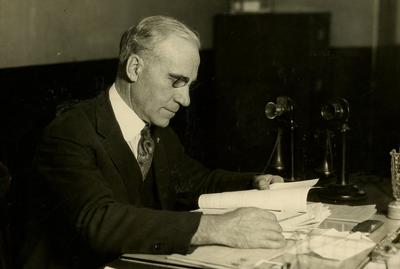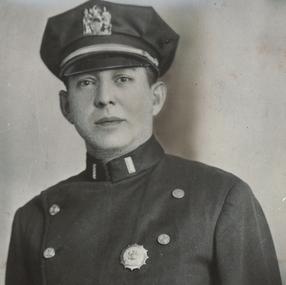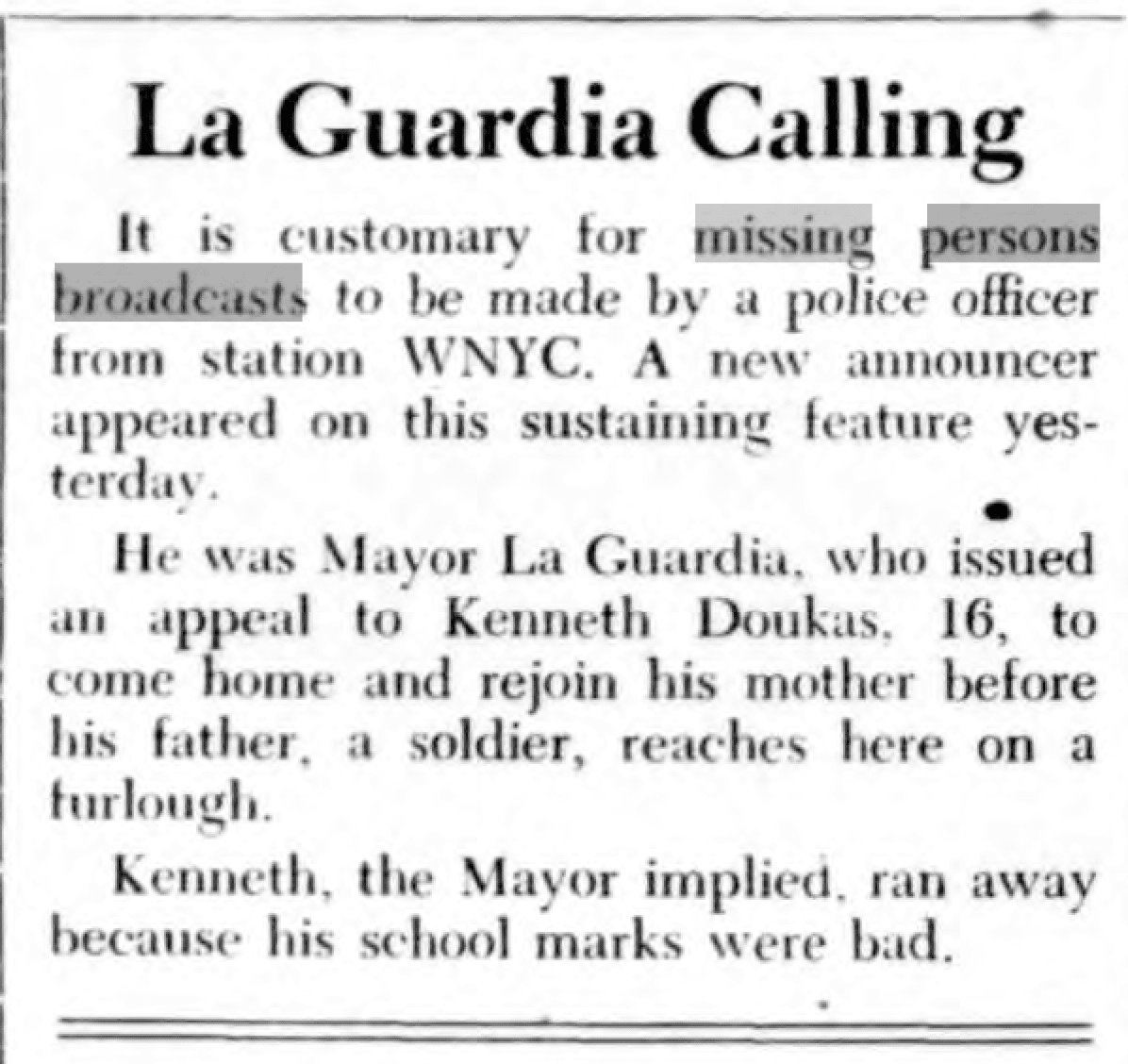 NYPR Archives & Preservation
NYPR Archives & Preservation
WNYC and the NYPD Agree, Don’t Run Away from Home!

It should come as no surprise that as a city-owned and operated station, WNYC maintained a good relationship with the New York City Police Department, serving early on as part of its communications apparatus for locating missing persons. In fact, the Missing Persons Alarms or reports are among the oldest of WNYC's regularly broadcast features, beginning with the launch of the station in July 1924. The NYPD Missing Persons Bureau was then only six years old and under the direction of Captain John H. Ayers (1897-1943). Initially, the programs were nothing more than the names and descriptions of people who had disappeared and were sought by friends and relatives. Said, Ayers:
"When the detective rings off, I direct that a radio broadcast regarding Bennett's disappearance be made through Municipal Broadcasting Station WNYC. We give a complete description of the missing man; his age, height, weight, color of his hair, eyes, the clothing he wore, his teeth, scars, birthmarks."[1]
WNYC Missing Persons Alarm, December 2, 1931.
Later, the broadcasts included short 'sermons' or homilies about why it is unwise to run away from home and the like, written by the announcing officers themselves. Profiling the reports in 1940, New York Sun writer Samuel Kaufman got a bit hyperbolic when he described the daily five-minute program as "packed with more drama, pathos and human interest than many stations present in a full day's broadcast."[2]
From 1934 to 1943, the NYPD Missing Persons Bureau was headed up by Captain John G. Stein (1879-1972), who, following in Ayres' footsteps, also broadcast regularly from WNYC in "a clear flexible voice" radio experts called "ideal for broadcasting."[3] Within a year of taking command of the bureau, Stein took the show from five to fifteen minutes daily and brought in four additional detectives who first had to pass an audition and reportedly opened each program with "the wail of a police siren."[4] Among the new reader-detectives was George L. O'Connor, profiled by writer and veteran newspaperman Joseph Mitchell.
"...Every weekend throughout the winter he goes swimming among the ice floes and grapefruit rinds in the surf at Coney Island; he is in fact, President of the Icebergs Athletic Club. He writes sentimental poetry. He used to be a tap dancer with a Primrose and Dockstader minstrel show, and at 48 is still able to make a lot of noise with his shoes. 'However,' he said today, 'I think my most important accomplishment is my Missing Persons human interest broadcast. I am a keen student of psychology, and I take these stories from the original files, stories of broken home ties, and broadcast them over WNYC, the municipal broadcasting station, at 1 P.M. on Sundays. I write a poem about each case and finish up with that, and I feel the broadcast is an important police service…’ ”[5]
Stein wrote the broadcasts brought in many tips and responses, including word from the missing themselves, who knew to tune in "on the chance of hearing themselves described, then 'phone in and complain if they weren't."[6] The progressive tabloid PM noted that a lot of women listened to Captain Stein over WNYC. Because of this, Stein explained he would not broadcast the name and description of missing young women until several days had passed, at the risk of soiling a girl's reputation.
"Why should everybody in Flatbush know Mabel wasn't home last night? Suppose a year from now Mabel gets married. Say she married Harry. They put it in the papers. The neighbors read about it. Should they be able to discuss with each other, 'I wonder if Harry knows about that night Mabel didn't come home? It was on the radio. I heard it myself! Most of these things are only overnight disappearances. Girls around 16, the foolish age, when they think they know everything. Women, women!" [7]
The Missing Persons broadcasts were highlighted with the opening of the station's new WPA-built studios on October 23, 1937. In the day's featured radio drama, The Voice of the People, Mayor La Guardia and other officials played themselves as they extolled the virtues of the city's radio station through a series of vignettes. In one dramatized segment a boy listener complains to his father that WNYC is boring, "No movie stars or nothin'. " His father, however, points out the excitement inherent in the daily Missing Persons Report direct from police headquarters. "There's material for a dozen novels, and all true stories, too," says the father before he describes one case solved with WNYC's help that segues to the drama. [8] Even Time Magazine recognized the broadcast's effectiveness in helping to find runaway girls in the big city, noting, "an appreciable few went home in response to the Bureau's famed daily five minutes of missing persons alarms over 'New York City's Own Station,' WNYC, kindly father of this sort of broadcasting..."[9] For Walter Winchell, they were one of his many bullet points noting in his syndicated column, "the missing persons broadcasts at the World's Fair packed more drama than all the sketches [on radio]." [10]
After what appears to be a brief hiatus, the missing person reports were reintroduced in March, 1956 with five-minute bulletins four times a week. A WNYC press release referred to the broadcasts as 'missing persons alarms,' that "will expedite the location of many amnesia cases, runaway youngsters and others who are reported lost by their worried families."[11] Below, courtesy of the Municipal Archives is the inaugural broadcast for the renewed bulletins.
At this writing, it is not clear when this 'renewed' Missing Persons report came to an end, but the station cited the broadcasts in a submission to the FCC as late as 1982, saying, "WNYC maintains a permanent remote facility at the Police Department's Missing Persons Bureau. On a regular basis, as it has for over 40 years, the station reports information therefrom at 1:50 PM. Finding persons as a result of the broadcasts has had noteworthy results."[12]
Nevertheless, cooperation between the city-owned WNYC and the NYPD was part of the station's DNA and extended to various public relations and community-oriented programs. Among the police-sponsored shows were Pals of the P.A.L. a youth variety show and a singing safety policeman on The Police Safety Program, a show for younger children. The police and WNYC also worked closely on most issues around civil defense and on Election Day with the communications involved with the release of polling returns through the police department's facilities.
________________________________________
[1] Ayers, John H., and Carol Bird, Missing Men, The Story of the Missing Persons Bureau of the New York Police Department, 1932, pg.15. The screenplay for the 1933 film Bureau of Missing Persons, starring Bette Davis, was adapted from this book.
[2] Kaufman, Samuel, "Drama in Capsule Form," The New York Sun, 1940.
[3] Livingston, Armstrong, and John G. Stein, The Murdered and the Missing, Stephen-Paul Publishers, New York, 1947, pg. 66.
[4] "To Hunt Missing by Radio," The New York Times, September 22, 1935, pg. N11.
[5] Mitchell, Joseph, The New York World-Telegram, May 9, 1936
[6] Livingston, Armstrong, and Capt. John G. Stein, pg. 103.
[7] Ager, Cecelia, "The Missing Girl's Best Friend," PM, May 4, 1942, pg. 22.
[8] Original WNYC script for The Voice of the People, October 23, 1937
[9] Time Magazine, February 27, 1939.
[10] Winchell, Walter, "Walter Winchell on Broadway," The Binghamton Press, July 13, 1940, pg. 21.
[11] WNYC Press Release, March 1, 1956.
[12] Federal Communications Commission Reports, Volume 91, Second Series, October 1982-April 1983, Application for Special Service Authorization, Docket # 11227, September 23, 1982, pg. 773.


